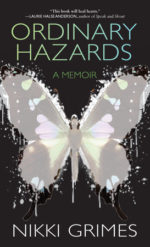Reviews of the 2020 Boston Globe–Horn Book Nonfiction Award Winner and Honor Books
Nonfiction Winner
 Infinite Hope: A Black Artist’s Journey from World War II to Peace
Infinite Hope: A Black Artist’s Journey from World War II to Peace
by Ashley Bryan; illus. by the author
Middle School, High School Dlouhy/Atheneum 107 pp.
10/19 978-1-5344-0490-8 $21.99
e-book ed. 978-1-5344-0491-5 $10.99
Ashley Bryan was a nineteen-year-old art student when he was drafted into a segregated army unit of stevedores, where he used every opportunity to sketch and record his experiences, from training to D-Day and its aftermath. Bryan’s present-day text serves as a kind of voice-over to the scores of images included: original paintings and drawings, letters, journal passages, photos, maps, and army posters. This wealth of overlapping visual elements could have resulted in a cluttered presentation; instead, the dynamic book design and lavish production choices make this a fully immersive experience. The ultimate gift book for Ashley Bryan fans. (Some of this material can be seen in “Ashley Bryan’s WWII Drawings” by H. Nichols B. Clark in our May/June 2018 issue.)
From the November/December 2019 issue of The Horn Book Magazine.
Honor Books

Ordinary Hazards: A Memoir
by Nikki Grimes
High School Wordsong/Boyds Mills 325 pp.
10/19 978-1-62979-881-3 $19.99
As poetically written as Woodson’s Brown Girl Dreaming (rev. 9/14) with a story as hard-hitting as Sapphire’s Push. In her author’s note, poet Grimes (winner of the 2017 Children’s Literature Legacy Award) says that memoirs focus on truth, not fact. Because of the childhood trauma she suffered, she has limited memories of her early years but has constructed the truths of her life from a patchwork of recollections; photos obtained from friends and family; and a few artifacts salvaged despite the frequent moves of her impoverished family and time spent in foster care. Overshadowing most of the story, her mother’s mental illness (paranoid schizophrenia), alcoholism, and marriage to an abusive and irresponsible man made Grimes’s early life hazardous. In a childhood in which she had to elude rats in her apartments and bullies and gangs in her neighborhoods and in which she was sexually violated by her stepfather, young Nikki found solace and confidence through her identity as a writer. She was supported and nurtured by her sister, from whom she was separated at age five; by her father, a violinist who immersed Nikki in Harlem’s Black Arts scene; and by an English teacher who insisted on excellence. As her story unfolds (the book is arranged in sections, chronologically, beginning in 1950 and ending in 1966), the striking free-verse poems powerfully convey how a passion for writing fueled her will to survive and embrace her own resilience. “My spiral notebook bulges / with poems and prayers / and questions only God / can answer. / Rage burns the pages, / but better them / than me.” A must-read for aspiring writers. MONIQUE HARRIS
From the September/October 2019 issue of The Horn Book Magazine.
 It Began with a Page: How Gyo Fujikawa Drew the Way
It Began with a Page: How Gyo Fujikawa Drew the Way
by Kyo Maclear; illus. by Julie Morstad
Primary Harper/HarperCollins 48 pp.
10/19 978-0-06-244762-3 $17.99
"In early 1960s America, a country with laws that separated people by skin color," Japanese American artist Gyo Fujikawa (1908–1998) helped break the color barrier in picture books with her now-classic Babies. Author Maclear lucidly outlines a remarkable life of art and creativity, of struggle and perseverance. Growing up in California, Fujikawa excelled at drawing but "sometimes still felt invisible among her mostly white classmates." This feeling of isolation would continue into adulthood and an art career in New York City, and especially during WWII when her West Coast–based family was incarcerated in internment camps. The telling makes smooth transitions between stages in Fujikawa's life, culminating in the publication of Babies in 1963: "At the library and bookshop, it was the same old stories...a world of only white children. Gyo knew a book could hold and do more." Morstad's illustrations — in liquid watercolor, gouache, and pencil crayons — effectively vary in style and coloring to match events. In a WWII scene, a simple black line drawing shows the Fujikawa family looking fearful before an armed guard. During scene of Babies's creation, the art capably mimics Fujikawa's own, with a diverse cast of frolicsome tots dotting an open layout, "welcoming kids in from the edges, from the corners, from the shadows." An appendix includes a photo-illustrated timeline, notes, and sources. KATRINA HEDEEN
From the November/December 2019 issue of The Horn Book Magazine.
The 2020 Boston Globe–Horn Book Award winners and honors were announced at SLJ's virtual Day of Dialog and via live stream on May 27th, 2020. For reviews of the winning titles and more, click on the tag BGHB20.
RELATED
ALREADY A SUBSCRIBER? LOG IN
We are currently offering this content for free. Sign up now to activate your personal profile, where you can save articles for future viewing.






Add Comment :-
Be the first reader to comment.
Comment Policy:
Comment should not be empty !!!